DISCLAIMER: THIS PAGE DOES NOT PROVIDE MEDICAL ADVICE
This page is intended for informational purposes only. No material on this page is intended to be a substitute for professional medical advice, diagnosis, or treatment. Always seek the advice of your physician or other qualified healthcare provider before changing your dietary or cooking habits.
Cast iron gets a lot of press when the topic of healthy cookware comes up. But carbon steel deserves a place in the spotlight, too. As cast iron’s lightweight cousin, carbon steel offers all the benefits of an iron skillet while being more versatile and easier to handle.
So is carbon steel safe? What are the health risks and drawbacks associated with using and seasoning carbon steel pans?
In this article, I’ll review the health concerns surrounding these kinds of pans.
Are Carbon Steel Pans Safe?
Carbon steel is generally a very safe cookware material – and has been used by professional chefs for centuries. But there’s no such thing as 100% safe cookware with no caveats.
Is Carbon Steel Non-Toxic?
Carbon steel cookware is generally considered non-toxic. It lacks potentially harmful chemical coatings found in some nonstick pans and does not contain elements like nickel, which is present in stainless steel.
While carbon steel is reactive with acidic foods, potentially leading to iron leaching, this is not inherently harmful and can even be beneficial for those with low iron levels. However, individuals with conditions like hemochromatosis should be cautious. The key to minimizing any risks is to maintain a well-seasoned pan, which creates a barrier between the food and the metal, reducing the chances of iron transfer.
What Is Carbon Steel Cookware?
Carbon steel is an alloy of iron and carbon. These are the same elements used in cast iron, but they’re different in the percentage of carbon and iron.
While a cast iron pan contains around 96% iron and 4% carbon, the ratio for carbon steel is 97% – 99% iron and 3% – 1% carbon.
Manufacturers might also include other metals in the alloy, altering the qualities of carbon steel.
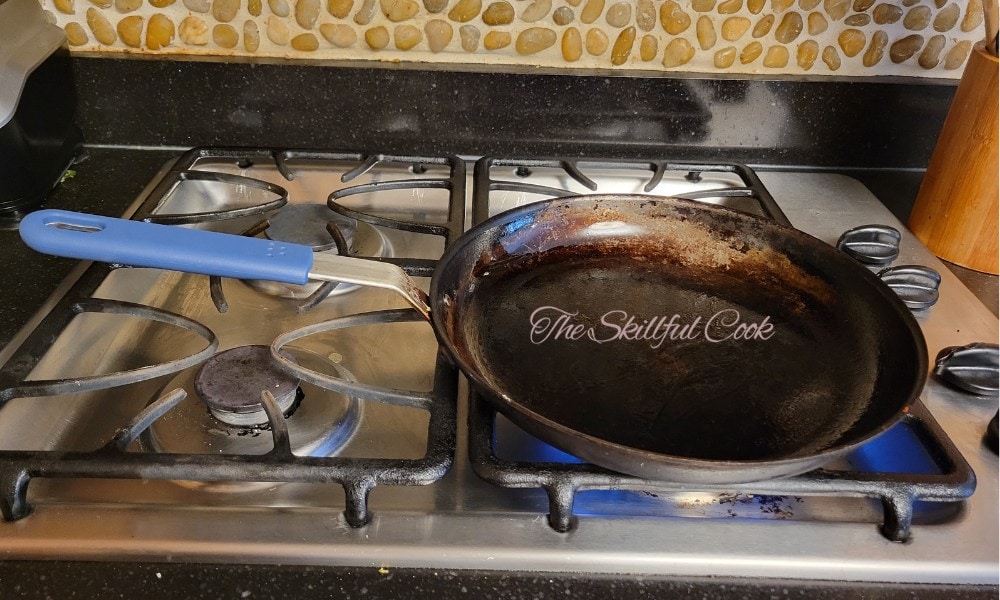
Cast iron’s brittleness makes it prone to the wear and tear of everyday cooking. To compensate, manufacturers make their cast iron products thicker, which means more iron and more strength. But the downside is that cast iron pots and pans are heavy and difficult to handle.
This is where carbon steel’s most praised quality emerges. The lower carbon content makes it stronger than cast iron. So, there’s no need to make it thicker to prevent breaking. This means carbon steel cookware is much thinner and lighter than cast iron.
Carbon Steel Manufacturing Processes
Apart from carbon and iron ratios, carbon steel and cast iron cookware have different manufacturing processes. Cast iron skillets are produced by hot iron poured into a mold. But since carbon steel has a lower carbon content, it’s more malleable and workable. Manufacturers get their raw materials as carbon steel sheets.
These sheets are spun or stamped on pre-made casts using physical pressure. This is totally different from cast iron manufacturing, which involves pouring melted iron into die casts. Thus, cast iron cookware has integrated handles and cast-iron lids, while carbon steel pans have riveted handles and generally don’t come with lids.
Check out this satisfying video to see how carbon steel pans are made.
Pros and Cons of Carbon Steel
The unique benefits of carbon steel make it the go-to choice for many home and professional cooks. Carbon steel pans are known for these features.
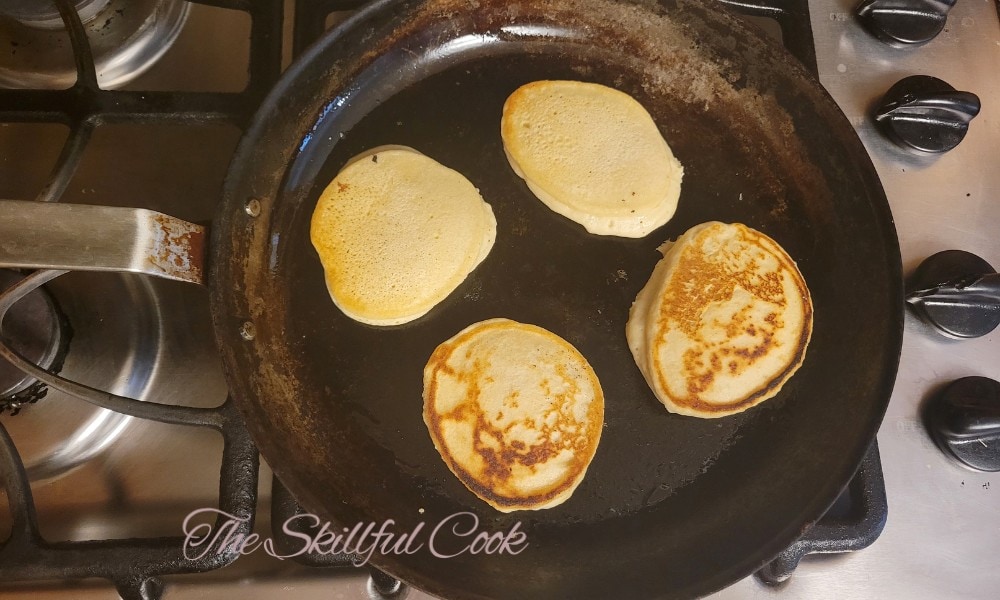
However, carbon steel isn’t without faults.
Despite these negatives, carbon steel is still one of the most sought-after cookware materials. The less even heating and heat retention aren’t deal-breakers for many since they’re hardly noticeable in most cooking situations.
Is It Safe to Cook in Carbon Steel?
Carbon steel is among the safest cooking options out there. It doesn’t contain chemicals such as PFAS that can be found in some nonstick cookware. It doesn’t contain nickel like stainless steel does.
However, the iron in carbon steel is reactive and can impart metallic flavors to your food if you cook acidic foods with it. Let’s dig into all of the potential safety issues with carbon steel.
Reacting with Acidic Foods
Raw iron reacts with acidic foods like vinegar or tomato sauce. Strong thick layers of seasoning can reduce the reaction, but the longer you keep acidic foods in a carbon steel pan, the higher the chances of acids eating away at the seasoning and then the metal itself. This is problematic for several reasons: it can damage your cookware, make your food taste off, and add extra iron to your diet.
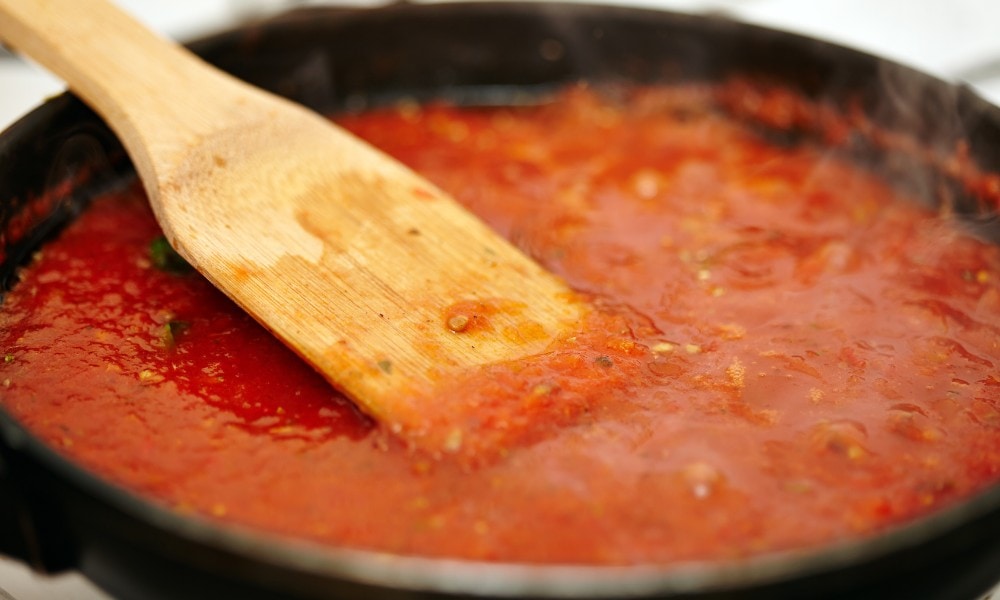
Iron leaching from carbon steel cookware into your food isn’t always bad. If you have low iron levels, the iron you get from cooking on carbon steel is unlikely to hurt you. In fact, iron deficiency is a worldwide health concern, so many people can actually benefit from getting iron from their cookware.
But if you have too much iron in your blood, you may want to be more cautious. Iron overload has been linked to the release of free radicals and oxidative damage. And if iron cookware is good for anemia, it can worsen conditions like hemochromatosis.
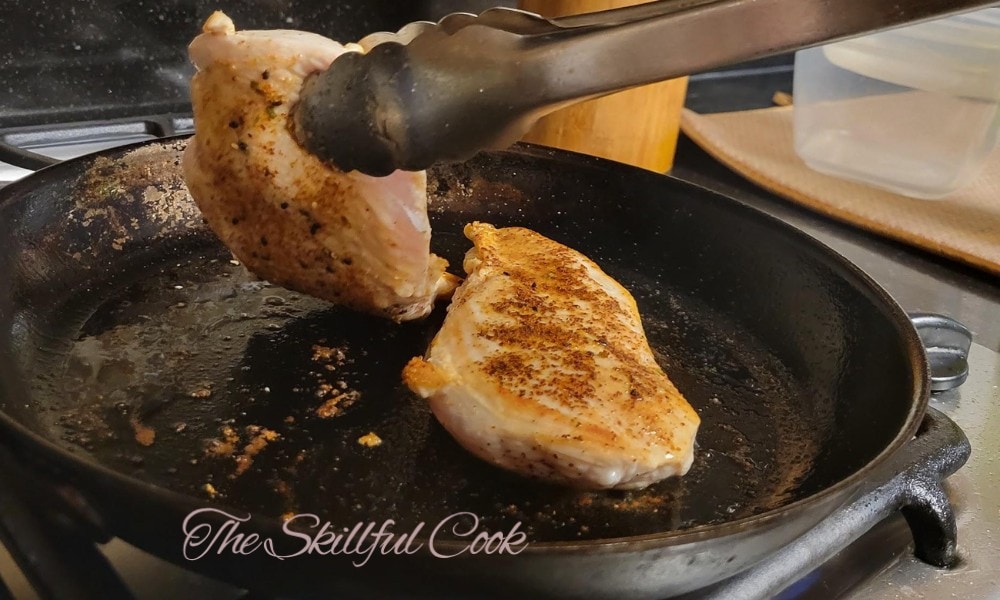
Consult your doctor about using carbon steel cookware. Cooking in a well-seasoned pan and avoiding using acidic foods in it can lower the chances of leaching iron into your food. A very well-seasoned carbon steel should not have serious leaching issues even if it has brief contact with acidic ingredients, for instance, if you deglaze with wine.
Warping
Carbon steel can warp under high temperatures – but it’s not the heat that makes it warp. Carbon steel actually has wonderfully high heat tolerance. The problem is heating a pan too rapidly. Carbon steel pans are notorious for warping on induction or electric cooktops that heat so quickly that the pan expands unevenly.
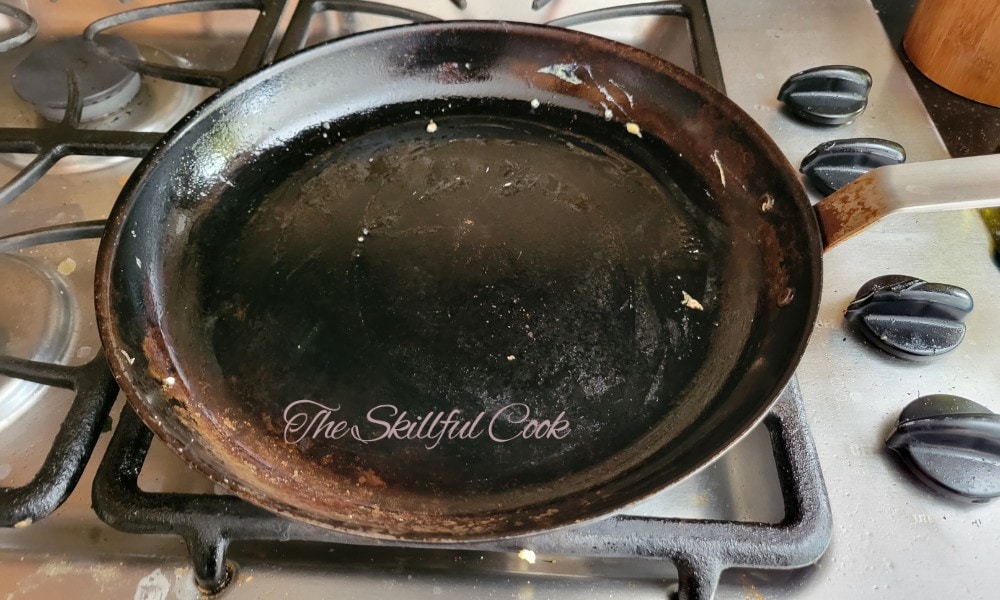
Warped cookware doesn’t sit evenly on the cooktop. This unstable base can cause threats like overturns and burns. Plus, you’ll find that a warped pan heats unevenly and is hard to cook with.
Seasoning
If you know how to season cast iron, you know that seasoning is a layer of polymerized and carbonized oil. The seasoning oil is heated beyond its smoke point – and science tells us that we definitely don’t want to consume oil that’s been overheated!
So, does that mean seasoning carbon steel is dangerous? There are two concerns here: harmful fumes and stripped-off seasoning.
Harmful Fumes
Seasoning carbon steel involves a considerable amount of smoke. You need a thin layer of oil baked into the pan’s surface under high heat, which is past the oil’s smoke point. This method will inevitably create smoking.
Plus, the carbonization stage, which gives the seasoning its pitch-black color, can’t happen without smoking. And we know that oil fumes can be dangerous, even if they’re not their past smoke point.
A Chinese study found that prolonged exposure to cooking oil fumes can contribute to lung cancer in nonsmoking women.
It’s definitely something to keep in mind, but it probably shouldn’t discourage you from buying carbon steel or cast iron. This is because we don’t season our carbon steel pans every day. In most cases, 3-4 seasoning layers will be enough to give you a durable nonstick surface. If you keep your kitchen well-ventilated, you can drive out the smoke quickly.
Seasoning on a stovetop can be better than doing it inside an oven. Oven seasoning typically takes longer; you need to bake the pan in the oven for 30 minutes to one hour. But seasoning your pan on a gas stove takes less time, allowing you to get rid of the smoke more quickly.
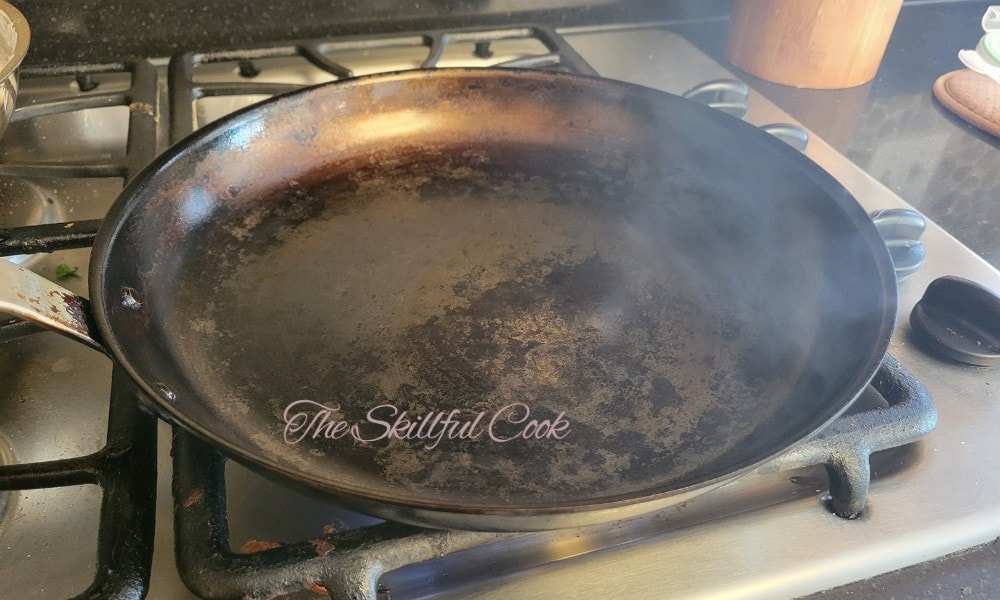
I’ll also add that if you are seeing a lot of smoke billowing from your pan when you’re seasoning it, you probably have way too much oil on the pan. Aggressively wipe excess oil from the pan as you’re seasoning it.
In an ideal world, you would be able to season your carbon steel once, handle it carefully, and let the seasoning continue to build naturally as you cook with your pan. Just be careful not to overheat oils when you’re cooking.
Stripped-off Seasoning
The seasoning layer on a carbon steel pan creates a barrier between the raw metal and our food, reducing concerns about iron transfer. But seasoning can scratch, flake, or erode off the pan with use. Are chipped-off bits of seasoning dangerous since they’re bits of dry, polymerized oil?
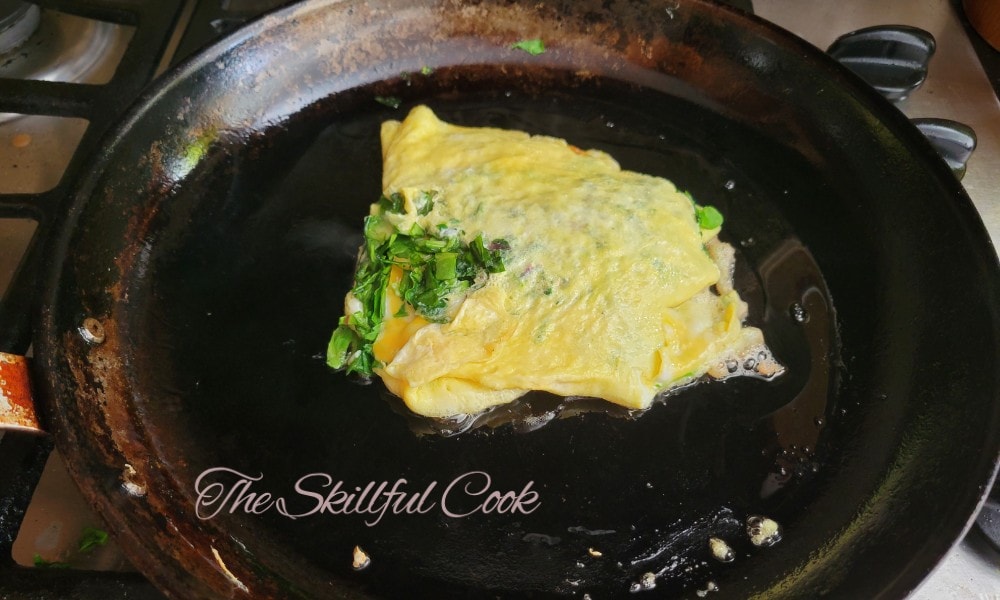
I didn’t find any research on whether consuming chipped-off seasoning can be harmful – and I dug deep. Your body is likely able to pass it through without digesting it. But if you want to minimize the chances of flaked-off seasoning finding its way into your body, here are some steps.
By following these tips, you can enjoy all the benefits of carbon steel while staying on the healthier side.
Is Rusted Cookware Safe To Use?
Carbon steel — like its heavier cousin, cast iron —- is notorious for being rust-prone. The high percentage of iron means it can react with oxygen in the air, leading to rust.
According to the FDA, rusted cooking utensils aren’t safe to use. If you dig a little deeper into the topic, you’ll find that most experts say rust itself isn’t harmful to humans. The concern is that the uneven surfaces on rusted utensils can harbor harmful bacteria.
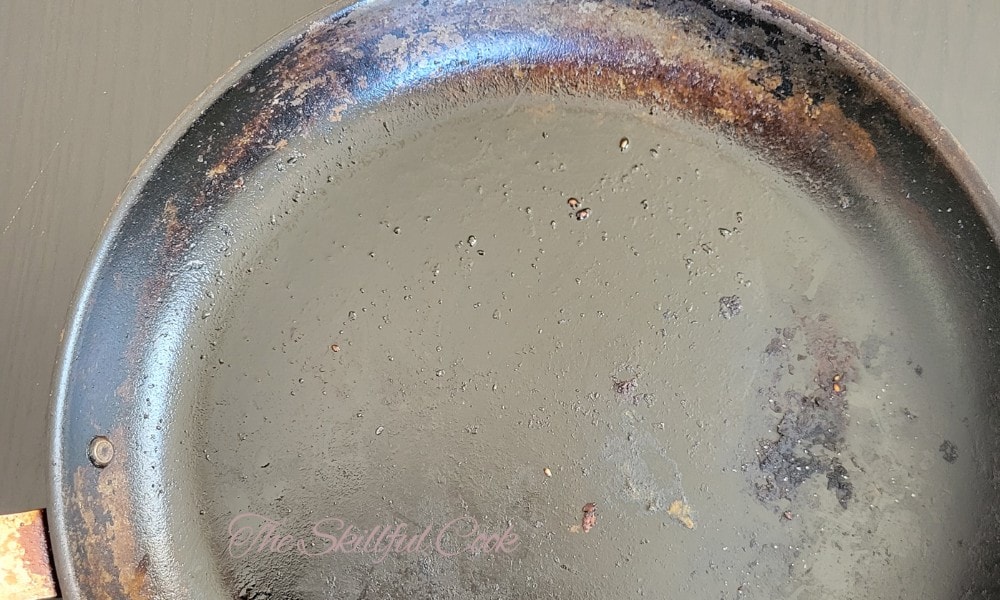
So don’t panic if your carbon steel pan does rust – it’s not ruined. But, for the sake of your health and your pan’s performance, do try to prevent your cookware from rusting! If your carbon steel pan is rusted, you should remove the rust and re-season the pan before use. Fortunately, rusty carbon steel can be salvaged pretty easily. Here’s what you can do:
Regardless of the method you use to remove rust, rinse the pan carefully to remove bits of soap or salt. Dry the pan completely and reseason it to restore its protective layer.
Tips to Prevent Rusting in Carbon Steel Cookware
Best Carbon Steel Pans for Healthy Cooking
One of the best things about carbon steel pans is that, no matter the brand, you know what you’re getting: iron with a bit of carbon mixed in. There are no chemical coatings, glazes, or polymers to worry about. However, some brands have higher construction quality standards than others.
Here are some of my favorite carbon steel brands.
Made In
Made In is a reputable French company that manufactures a wide range of cookware, from stainless steel to cast iron. Its carbon steel cookware ranges from classic pans and skillets to griddles, roasting pans, and woks.
My favorite carbon steel pan is this 12” Made In skillet. It’s highly heat tolerant, able to withstand up to 1200°F, making it warp-resistant. Plus, the smooth surface makes seasoning a breeze, allowing you to create a nice patina and barrier over the bare metal.
Merten and Storck
Merten and Stock is a German manufacturer that has been in the business since 1873. In addition to carbon steel, they have a full assortment of stainless steel and enameled cast iron cookware.
This preseasoned carbon steel fry pan is an affordable choice. It’s oven-safe and can withstand up to 600°F. Plus, it’s lightweight and highly maneuverable.
Conclusion
Carbon steel is generally safe and non-toxic. It contains carbon and iron — and trace amounts of other minerals — but doesn’t have a chemical or ceramic coating. It can react with acids and transfer iron into your food, which may or may not be a concern depending on your personal nutritional needs. Just make sure to handle oil safely when cooking in and seasoning hot carbon steel.
If you have experience cooking with carbon steel cookware in your kitchen, please share your insights with us in the comment section below!

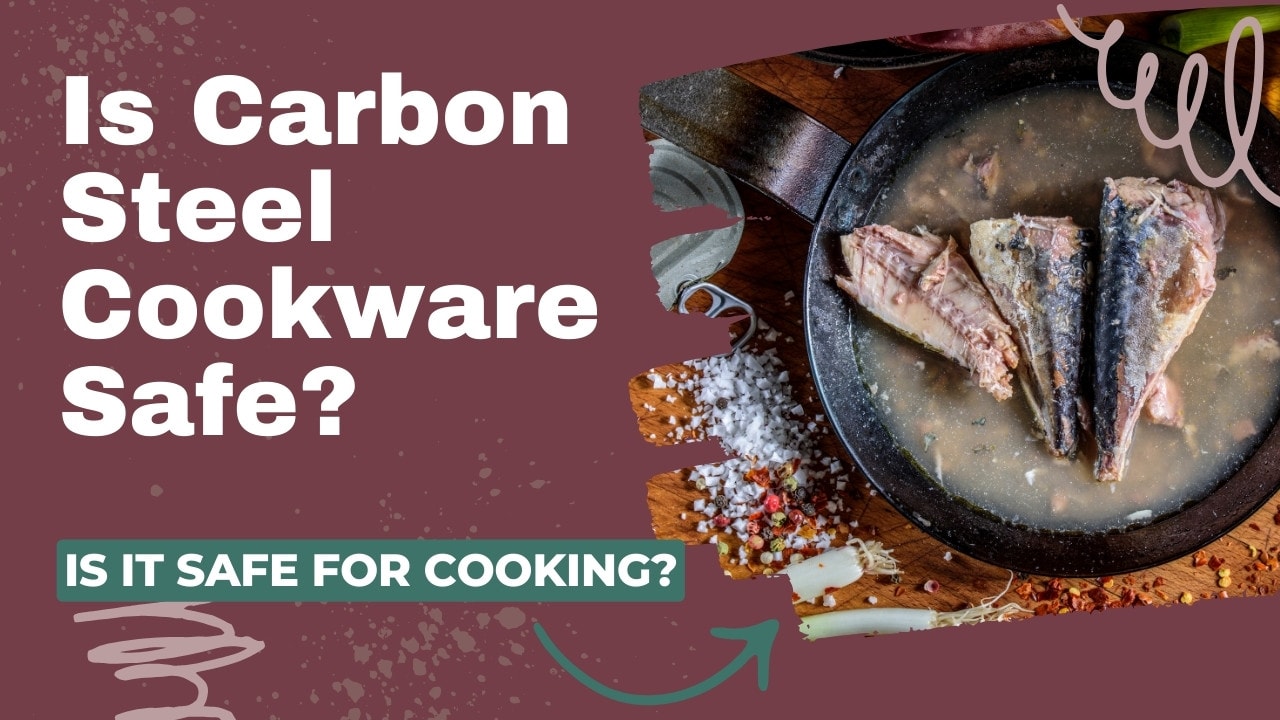










Good article, I would like it better if it dug a little deeper into which grades of carbon steel are suitable for cooking, e.g. 5160 or A29, 1095 etc., and what are equivalent grades for carbon steel pans currently on the market. Better yet, include any negatives associated with selected grades. DIY’ers could then determine if using 5160 in a fire pit for cooking is toxic, or simply using a 5160 stand to support a cast iron or stainless grill plate, or any other grade for that matter. Any thoughts?
Hey there!
You brought up an interesting point. I couldn’t find any reliable research on the safety of various carbon steel grades. The research I could find suggests that the usual carbon steel used in commercial cookware is safe. It might leach some iron, but that is not a cause for concern for most people.
Unfortunately, none of the well-known cookware brands specify the type of carbon steel they use for their skillets.
I wish I could be more helpful. Please let us know if you find more information about this!